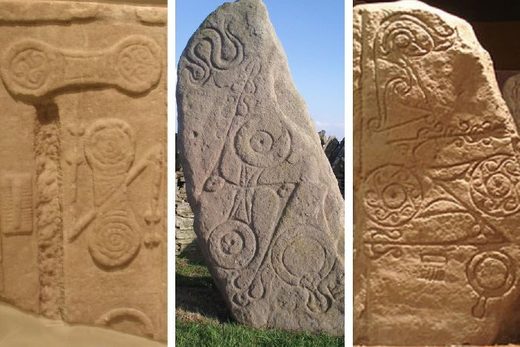Is key to indecipherable Pictish stones to be found in ancient Tibetan symbols?
Alison Campsie
Scotsman
Sat, 25 May 2019 20:16 UTC

© British Library.
Drawing of ancient Buddhist ceremony which shows Tibetan monks holding a bell and dorje - a thunderbolt symbol - which Dr TA Wise believed inspired the Pictish double disc symbol which can be found on standing stones across the north and east of Scotland.
Thomas A Wise, a doctor from Dundee, left Scotland 1827 to take up a position in the Bengal Medical Service. It was a journey made by many Scots medical graduates before him.
His 23 years in in India fuelled an intense interest in the cultural and social aspects of his adopted home. He wrote treatise on the Hindu system of medicine, diseases of the eye and preservation of ice while investing heavily in a hospital and servings as the Secretary to the Committee of Public Instruction in Calcutta.
But it was his theory that suggested the ancient Buddhists of Tibet travelled to Scotland to meet the Picts of the North and East that truly consumed the polymath.
On retiring from medicine in 1851, Dr Wise returned to Scotland and absorbed himself in ambitious archaeological projects, such as the excavation of the the Barry Hill hillfort near Alyth and the Iron Age broch near Dunrobin.
He became fascinated by the similarities he saw between the Tibetan objects in his collection of relics collected on his travels and the symbols etched into the Pictish standing stones of home.
His theory was that Buddhist missionaries came to Scotland and used the symbols as teaching tools before being developed by the Picts and used as a visual language.
In particular,
he drew comparisons between the dorje, the Tibetan thunderbolt symbol - which represents abrupt change in human consciousness - and the prominent Pictish symbol of the double disc.
Dr Wise also found similarities between Tibetan round towers and the cromlech, a form of single-chamber megalithic tomb.

© McManus Museum and Art Gallery
Dr TA Wise left Dundee to work for the Bengal Medical Service in the 1820s. He developed a deep interest in the antiquities, society and culture of his adopted homeland.
He wrote numerous papers on the subject which culminated in his final publication in 1884, The History of Paganism in Caledonia with an Examination into the Influence Asiatic Philosophy, and the Gradual Development of Christianity in Pictavia.
Several presentations to the Scottish Society of Antiquaries were made.
Christina Donald, curator of early history at Dundee Museum and Art Gallery, said: "His view was that Buddhist monks came to Scotland and used stones and symbols as teaching symbols for the Picts before Christianity took over.
"I wouldn't call it a crackpot theory but it is not a theory that would be accepted today, but it is interesting that no one has really come up with the definitive theory that explains Pictish standing stones."

The Pictish double disc symbol on standing stones found at (left to right) Monifieth, Aberlemno and Dunnichen. It's meaning is unknown.
Ms Donald said that Dr Wise was investigating Pictish era at a time when little research was being done on the group of people who populated parts of the North of East from around the 3rd Century and the 10th Century.
But his theories were far from perfect, she added.
Ms Donald said: "When he excavated Dunsinane Fort in Perthshire he claimed the skulls that were found there were from the Far East, so he did try and shoehorn his theories in where he could.
"But at the same time, he was thinking about these things at a time when very little was written about the subject. TA Wise was also one of the first to think of the stones as one body of work."

Dr Wise drew comparisons with the dorje, which represents the thunderbolt and an abrupt change in human consciousness in Tibetan Buddhism, and the double disc symbol used by the Picts.
"How we think of Pictish stones is almost the same today. The interpretation of Pictish stones, and how we think about them, hasn't moved on that much."
Ms Donald said
it was possible that the disc was merely a universal symbol used by both societies. There is no evidence that Buddhists travelled to Scotland around this period, she added.
Meanwhile, recent research in the North East has concluded that the Romans may have influenced the Picts in the development of their own written language about 1,700 years ago.
Work to accurately date Pictish sites was conducted by a team, led by Dr Gordon Noble at Aberdeen University and National Museum of Scotland at Dunnicaer, a coastal fort near Stonehaven.

© McManus Museum and Art Gallery.
A page from the notebook of Dr Wise which shows his work on the theory that connects Pictish symbols to those of Tibetan monks.
It is now believed that
the site is home to the oldest Pictish stones in Scotland with a new dating system placing the remnants to as early as 3rd Century AD.
Previously, scholars dated the country's earliest Pictish stones to anywhere between the 5th and 7th centuries
The new chronology also fits with the spread of Roman writing systems, suggesting the occupying force may have partially inspired their script and the use of symbols to represent significant names and places.
-Wise Ways, Travels of A Dundee Doctor examines the life and legacy of TA Wise and pulls together a number of artefacts from his collection, now in the keep of the city, as well as a selection of maps and drawing held by the British Library. The exhibition is currently on show at the McManus Museum and Art Gallery in Dundee.











